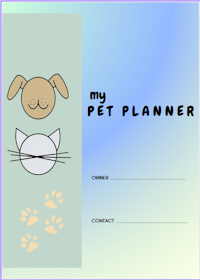Glen Of Imaal Terrier
An Irish Treasure!
The Glen of Imaal Terrier originated in Ireland's county Wicklow and was named after a glen in that region.
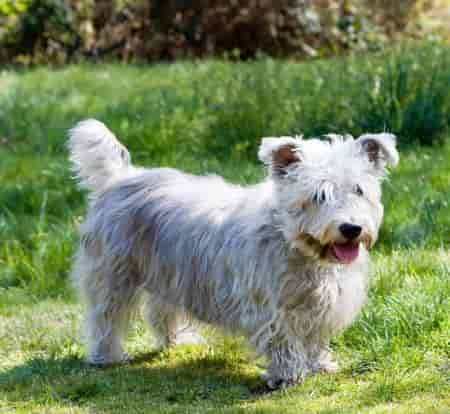 Glen of Imaal Terrier
Glen of Imaal TerrierNot much detail is known about the development of the Glen terriers, but it believed they joined the ranks of the dog world in the 1700s.
The Glen is a very rare terrier breed and the gene pool is not very large which can make it more time consuming for those wishing to obtain one.
Glens were used on farms as ratters and to hunt foxes and badgers - bearing in mind that a European badger weighs an average of 40 lbs. On other occasions, they were pitted against other dogs in fights.
Another unique job assigned to the Glen that provided a useful service, was working a dog wheel to turn the meat on a kitchen spit.
His short-legged profile made him just right for the job.
The Glen began appearing in America around the early 1900s, but it was not until 2004 that it was officially recognized by the
American Kennel Club.
The Glen of Imaal is a very attractive and confident little dog. His somewhat shaggy look gives him a mischievous expression.
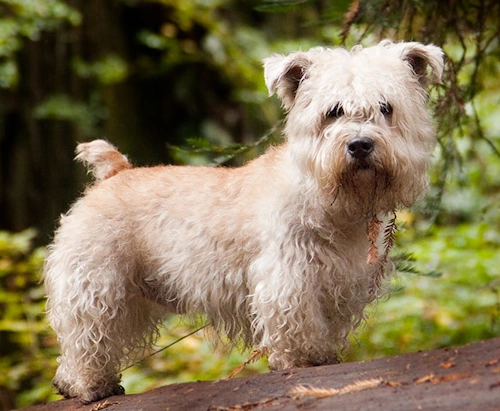
Characteristics Of The Glen of Imaal
Glen of Imaal Terrier is an intelligent dog with the expected courage of the
terriers. However, unlike many small dogs, he is not a barker - at least not without very good reason, which
makes him a good watchdog.
He is a very social dog and a good family protector. While being both agile and playful outside, he is more laid back inside the home.
Glens are responsive to their owners and should be obedience trained because they have a bit of stubborn
streak. They can also be aggressive toward other dogs when mature, so it's essential to socialize them from an early age. Puppy training classes would be ideal as well as provide the opportunity to interact with other dogs and humans.
On the positive side,
this confident dog is strong and very flexible and enjoys success in agility competition, as well as conformation
and earth dog sports.
The best approach to training a Glen is with kindness and consistency, mixed with playful interruptions. Use positive reinforcement to keep him motivated.
Like many terriers, Glens tend to lose focus, or get bored, if training sessions are not kept short. But, luckily, he's a quick learner!
Glen of Imaal Terrier Appearance And Care
Height: 14 inches
Weight: 34-36 lbs.
Color variations: Wheaten, Blue or Brindle
in all shades.
The Glen is a sturdy little terrier with a good amount of substance in his well-muscled body which is longer than it is tall. Its front legs are a little
bowed and the front feet turn out. Its ears are rose or semi-prick when alert.
The hindquarters in particular are very muscular. The docked tail is set
high and carried erect.
The double coat is of medium length with a harsh outer texture and a soft undercoat. It will get matted if it is not maintained with
regular combing and brushing with a slicker brush about twice a week.
Clipping of the coat is not advised as it will change its texture. Hand plucking with a stripping tool is the preferred method for coat maintenance and should be done every six months.
Selective trimming around the ears, paws, beard will maintain a more neat appearance. Also, regular removal of excess hair in the ear canal will help prevent infections.
Teeth should be cleaned daily and nails trimmed once a month or sooner if needed. Nail trims can be done with a dremel if you are hesitant with clippers. Bathe only when necessary.
Shedding is minimal with the Glen which makes brushing more of a priority to remove dead hair and allow air to circulate.
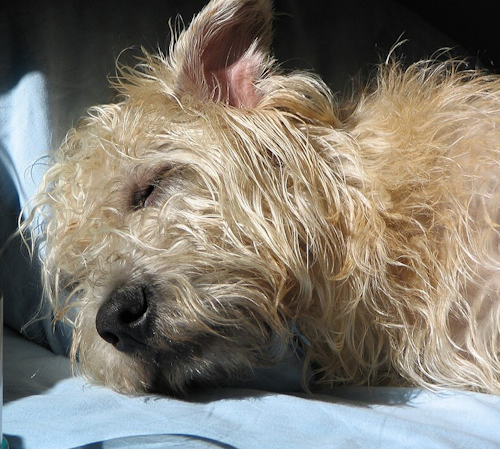 Enjoying a Nap!
Enjoying a Nap!Health Profile of the Glen
Glens are generally considered to be quite a robust little dogs that,
with good care and veterinarian oversight, can live up to seventeen years, although the norm would
be more
around thirteen or fourteen. It has less health-related issues than many other breeds.
The main health conditions that can affect the breed include:
- Hip dysplasia
- Inherited PRA (progressive retinal atrophy) which can lead
to blindness.
Since PRA is acquired genetically, there is a test to assist breeders in determining if the conditions for this disease exists in a dog they are considering for breeding.
- DM – Degenerative Myelopathy, a fatal disease that can affect the breed in its later years. There is a genetic test which breeders can use to screen their breeding stock to avoid creating at risk puppies.
One other thing to note: as a chondrodysplastic breed, the glen's bodily structure leaves the growing Glen puppy susceptible to growth plate fractures. This means that strenuous activities and jumping should be avoided until about one year of age, or until the growth plates have closed.
A good thing to keep in mind when talking with a breeder about obtaining a Glen of Imaal Terrier, is to ask to see the results of testing they have completed on the parents of the puppies for the conditions noted above.
Activity Level
The Glen of Imaal Terrier does not have a high exercise requirement.
He is quite adaptable to a moderate level of activity, though he is playful and does have good stamina. Daily walks are still necessary for the benefit of health as well as the mental stimulation they provide.
Try to prevent the Glen from jumping on couches or into vehicles or a lot of stair climbing until he has reached full growth as these activities can put too much stress on the joints - mainly because of his body structure.
Ideal Living Space
This breed can live quite happily in either a house or apartment providing he gets regular exercise and is taken out for walks.
That being said, a yard for playtime and training is always ideal, but make sure it is securely fenced as the Glen has a high prey drive and is an excellent digger!
How Is the Glen With Children?
Glen of Imaal terriers are very affectionate and generally have a good reputation with children when they’ve been trained and well socialized.
They can be good companions for respectful older children, and very willing to join in their games, but they might not always tolerant young boisterous kids.
That said, since children and dogs are unpredictable, activities between them should always be supervised by an adult.
A Companion for Seniors?
As a very loyal and devoted breed with relatively easy care, he makes a good choice for senior or more sedentary families.
Glens don’t require an excessive amount of exercise, but they do need daily walks and mental stimulation. They also need grooming and training from an early age.
These are a just a few things to consider that are necessary for a Glen's care no matter what the household.
Find A Glen To Adopt Or Buy
As mentioned earlier, this is a rare breed - last time I checked, only a thousand of them exist in the world. I don't think you will find any Glens with the casual breeder, but if you do - avoid!
But don't despair, while the wait may be longer than with a Golden Retriever, this is one breed to acquire from a reputable source. Because of the small gene pool, inbreeding can be an issue and something to inquire about when you meet a breeder.
By contacting breeders near you, you can find out when litters are expected and reserve a spot on their waiting list.
The price for a pedigreed puppy from a reputable breeder, is likely to be in the range of $3,700 to $4,200, with show quality dogs at the higher end.
Here are two resources to help you find a breeder or rescue for the Glen of Imaal terrier:
Book Recommendation
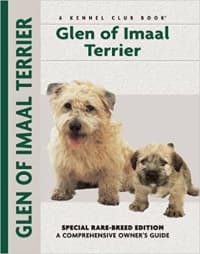
Glen of Imaal Terrier: Special Rare Breed Edition
A complete owner guide that includes information about the breed's ancestry, character and standard, proper selection, feeding, training, health care and behavior. Also advice about preparing for the puppy, house training and potential puppy problems. Many full color photos.
Before You Go...
If you like the content of this page, as well as others on my site, please give it some love by clicking on the heart in the lower right hand corner. This helps me to keep providing enjoyable and useful content.
Thank you.
- Home ›
- AKC Breeds ›
- Terrier Breeds ›
- Glen of Imaal Terrier
Image: pixabay author name "nolongerhere"
Glen napping: commons.wikimedia.org/wiki/File:Glen_of_Imaalinterrieri.JPG

